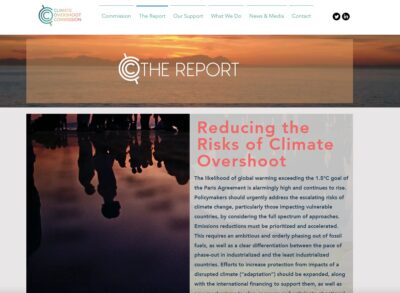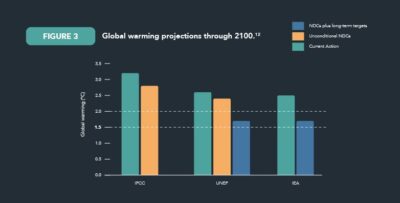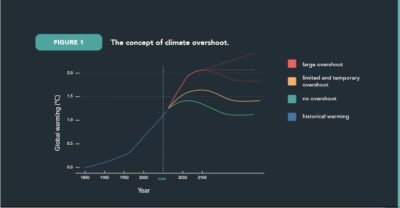The Climate Overshoot Commission Releases its Report
A dozen global leaders weigh in on the risk of exceeding the Paris temperature targets and what it means for climate response.
 The Climate Overshoot Commission recently completed its work, releasing its report at the United Nations last Thursday, September 14. This report comes in conjunction with the U.N. General Assembly and a collection of high-level climate and environment events, including the Sustainable Development Goals Summit, 18-19 Sept, and the Climate Ambition Summit, 20 Sept.
The Climate Overshoot Commission recently completed its work, releasing its report at the United Nations last Thursday, September 14. This report comes in conjunction with the U.N. General Assembly and a collection of high-level climate and environment events, including the Sustainable Development Goals Summit, 18-19 Sept, and the Climate Ambition Summit, 20 Sept.
 The Climate Overshoot Commission is a senior independent international body, consisting of twelve distinguished individuals from around the world, including former heads of government, national ministers, and leaders of major environment, development, and civil society organizations. Chaired by Pascal Lamy, former Director-General of the World Trade Organization, it was convened by the Paris Peace Forum. The UCLA Emmett Institute contributed to the establishment and work of the Commission in several ways. Two former Emmett Institute law fellows served on the Secretariat. UCLA law students provided research and analytic support to the Secretariat in the International Climate Law and Policy Clinic. I served as a senior advisor to the Secretariat. In this and a few subsequent posts, I’ll present highlights of the Commission’s contributions, with some commentary — my own views, of course, not those of the Commission, which has very cogently spoken for itself.
The Climate Overshoot Commission is a senior independent international body, consisting of twelve distinguished individuals from around the world, including former heads of government, national ministers, and leaders of major environment, development, and civil society organizations. Chaired by Pascal Lamy, former Director-General of the World Trade Organization, it was convened by the Paris Peace Forum. The UCLA Emmett Institute contributed to the establishment and work of the Commission in several ways. Two former Emmett Institute law fellows served on the Secretariat. UCLA law students provided research and analytic support to the Secretariat in the International Climate Law and Policy Clinic. I served as a senior advisor to the Secretariat. In this and a few subsequent posts, I’ll present highlights of the Commission’s contributions, with some commentary — my own views, of course, not those of the Commission, which has very cogently spoken for itself.
There have been dozens of international commissions. Some of you may recall the 1986 World Commission on Environment and Development, or Brundtland Commission, which first popularized the idea of “sustainable development.” Commissions generally aim to advance international debate on hard issues, typically when other bodies are constrained in their ability to do so. Commissioners bring experience, stature, broad global representation—but crucially, are not presently in political office, so they are not required to advance national positions. They can speak and discuss freely. Like its predecessors, the job of the Overshoot Commission was to say things that are true and important, but that other more politically constrained bodies are unable to say: to talk loudly about elephants in the room and naked emperors.
This boiled down to two jobs. The first was to sound the alarm about the imminent likelihood of global heating exceeding the Paris temperature targets. The second was to say what this high risk of exceeding the targets— “overshoot”— means for climate response.
For the first, the Commission did its job pretty well, albeit with some reservations. Its forceful opening message is that the likelihood of global-average heating exceeding 1.5°C above pre-industrial levels—the more ambitious of the Paris targets—is “alarmingly high and continues to rise.” This is a stronger statement of this risk than has been made by any similarly high-level climate body, although not nearly as strong as is justified. Exceeding 1.5°C is virtually certain: indeed, it’s quite likely to happen within the next decade. More seriously, the Commission was silent on the risk of exceeding the higher Paris target, 2.0°C—with much more severe impacts than 1.5°C— which is also high and mounting. The Commission did report recent  assessments from three bodies—the IPCC, UNEP, and IEA —which have synthesized projections of end-of-century heating. These are pretty alarming. Just maintaining present emissions-cutting actions—i.e., no further strengthening, but also no backsliding—give end-of-century heating of 3.2°C (IPCC), 2.6°C (UNEP), and 2.5°C (IEA); adding commitments in NDCs on top of current actions gets these down to 2.8°C (IPCC) or 2.4°C (UNEP); and adding conditional commitments and long-term net-zero targets reduces these to 1.7°C (UNEP and IEA). Getting better, but not very comforting.
assessments from three bodies—the IPCC, UNEP, and IEA —which have synthesized projections of end-of-century heating. These are pretty alarming. Just maintaining present emissions-cutting actions—i.e., no further strengthening, but also no backsliding—give end-of-century heating of 3.2°C (IPCC), 2.6°C (UNEP), and 2.5°C (IEA); adding commitments in NDCs on top of current actions gets these down to 2.8°C (IPCC) or 2.4°C (UNEP); and adding conditional commitments and long-term net-zero targets reduces these to 1.7°C (UNEP and IEA). Getting better, but not very comforting.
Deciding how to speak effectively about such projections is surprisingly hard, for a couple of reasons. First, such statements aren’t just scientific but are also political—intended to report what is known or knowable about a risk, in such a way as to elicit a certain kind of response. All public-facing bodies like the Commission fret over how to sound the alarm that bad things are coming, to convey an appropriate level of action-motivating alarm without inducing despair and passivity. Second, there is real uncertainty in such statements, which gets larger and is more dependent on human choice the further ahead you look. While exceeding 1.5°C is pretty much locked in, there is so much range for human action in longer-term projections like 2.0°C, that most bodies —like the three the Commission quoted—speak not in terms of likelihood, but in terms of if-then, conditional statements. If control measures are this strong, then we project this degree of heating. The Commission chose to focus on the 1.5°C target, to speak very forcefully about the likelihood of exceeding it, but not to suggest certainty or unavoidability.
To give the Commission credit where due—and it is due in many places—on one point closely related to these projections, they were uncommonly and admirably frank: Noting the risks and the stark tradeoffs posed by aerosol pollution in the lower atmosphere. This pollution, mostly from burning fossil fuels that contain sulfur, has severe current environmental and health effects, estimated to kill more than 5 million people per year due to respiratory illness. It is also exerting an inadvertent cooling effect that masks a large fraction—perhaps a third to a half—of the climate forcing from previously emitted greenhouse gases that are already in the atmosphere. This pollution has to be cleaned up—and is being cleaned up—notably via the recently enacted tightening of restrictions on the sulfur content of marine bunker fuels adopted by the IMO. But cleaning this up will remove its cooling effect, which the IPCC recently estimated as 0.7°C.
Another related contribution the Commission made to climate clarity and realism (although less than it perhaps might have) concerns the use of the term for which it was named, “Climate Overshoot.”
Overshoot scenarios initially appeared in integrated assessment models (IAMs). They are projections in which some measure of environmental disruption initially exceeds a target, e.g., one of the Paris global temperature targets, but then stops growing, reverses, and eventually returns to the target level after this temporary period of exceedance. Calling these “overshoot scenarios” makes sense in describing model results, but is somewhat misleading in the real world, because it implies that once you exceed a target you are on an overshoot trajectory, which will in due course reverse and return to the target. In other words, the term suggests that such reversal and return is somehow automatic or easy, perhaps even built into the definition of “overshoot.” But what is actually highly likely is not the complete overshoot trajectory, but the initial exceedance of the target. How large and long-lasting the exceedance is, indeed, whether temperature actually returns to the target at all rather than just staying higher, depends on what happens to net  emissions afterwards. Returning to or below the target, let alone doing so after just a small and brief exceedance, will take the same extreme reductions in emissions that have been so challenging to achieve thus far, now with the additional requirement that any continuing emissions be more than offset by extreme scale-up of stable atmospheric removals. Current and coming advances in carbon-free technology will help, of course. But given decades of shortfall in reducing global emissions, and continuing structural factors hindering needed sharp reductions, there is no justification to assume this vast transformation will somehow get easy, let alone automatic, by the mere fact of exceeding the targets and suffering the resultant worse climate impacts. Fossil interests will keep fighting, even it’s to stretch their demise out longer rather than to live forever. Perhaps increasingly severe climate change and impacts will make transformative socio-technical change easier, but this depends on political assumptions – theories of social change – that are not clear.
emissions afterwards. Returning to or below the target, let alone doing so after just a small and brief exceedance, will take the same extreme reductions in emissions that have been so challenging to achieve thus far, now with the additional requirement that any continuing emissions be more than offset by extreme scale-up of stable atmospheric removals. Current and coming advances in carbon-free technology will help, of course. But given decades of shortfall in reducing global emissions, and continuing structural factors hindering needed sharp reductions, there is no justification to assume this vast transformation will somehow get easy, let alone automatic, by the mere fact of exceeding the targets and suffering the resultant worse climate impacts. Fossil interests will keep fighting, even it’s to stretch their demise out longer rather than to live forever. Perhaps increasingly severe climate change and impacts will make transformative socio-technical change easier, but this depends on political assumptions – theories of social change – that are not clear.
An illustration of the deep difficulty thinking coherently about exceedance and overshoot can be found right in the recent IPCC AR6 report—a point the Commission discovered in the course of its work but did not include in its report. The overshoot scenarios reported in the IPCC all fall into two buckets: “low overshoot,” in which 1.5°C is exceeded by at most 0.1°C (this bucket also includes a tiny number of scenarios with no overshoot at all, but to be a little glib, nobody believes those); and “medium to high” overshoot, in which 1.5°C exceeded by 0.1 to 0.3°C. A casual read could be forgiven for inferring that these numbers reflect a reasoned conclusion by the IPCC that these are the biggest overshoots the world will likely have to deal with. But unfortunately that’s not what it means at all. These buckets with their low overshoot numbers are a definitional artifact, arising from the year-2100 endpoint of the analyses. For a scenario to be called “overshoot,” it had to get back to its target by the year-2100 end of the analytic time horizon. Scenarios that peaked above 1.8°C—i.e., that exceeded 1.5°C by more than 0.3°C this century– did not have time to get back below 1.5°C by the end of the century, so were not labeled or analyzed as overshoot. Even more so, no scenario that exceeded 2.0°C could be called overshoot, because there is not enough time on any trajectory to exceed 2.0°C, reverse, and return to 2.0°C by the end of the century. So, the overshoot scenarios identified and analyzed as such are in fact the best possible trajectories in which 1.5°C is exceeded, which manage to get back to 1.5°C by 2100. The IPCC in no way ruled out or judged unlikely future trajectories with higher and longer-lasting exceedances. These are there—in fact, they are clustered into buckets by their end-of-century heating. These include, for example, the scenarios I reported above, in which continuance of present policies or NDC commitments without increasing ambition (granted, a scenario that may be unlikely on the pessimistic, no-action side) give end-of-century heating of 3.2°C and 2.8°C, respectively (with the lower figures subsequently estimated by UNEP and the IEA, as noted above).
Having sounded the alarm about the likelihood of overshoot—albeit pulling their punches a little in concession to the perceived need to give a positive message—the Commission’s second job was to say what this high risk of overshoot means for climate response.
At first cut, this is a simple story: do more of everything and do it faster. But given the widespread desire not to face the stark likelihood of potentially severe exceedance, there actually is more to say—in particular, that the gravity of risks requires consideration of more extreme or radical approaches to limiting climate change than have gained serious attention thus far. It is no longer acceptable to deem plausible solutions that might help inadmissible a priori.
The Commission did this and did it pretty well—to varying degrees across the four major response types, of which they addressed all – mitigation, adaptation, removals, and solar geoengineering or SRM. Indeed, given the current state of climate debate, merely including all four response types with similar levels of scrutiny and detail represents a significant contribution. They also presented a useful and original conceptual framework for thinking about climate responses in presence of overshoot, dividing the four response types into two pairs according to which of two large-scale aims they pursue: Reducing the magnitude and duration of overshoot; and reducing the harms that follow from any given magnitude and duration of overshoot. The two responses that limit the magnitude and duration of overshoot are mitigation and removal: deep cuts in present and future emissions; and removing past emissions from the atmosphere and putting them somewhere long-term secure. The two ways to limit the harms resultant from any specific magnitude and duration of overshoot are adaptation and solar geoengineering (Sort-of, on the last one: the Commission doesn’t recommend solar geoengineering—in fact, its immediate recommendation is to enact a moratorium on it—but it also recommends researching it and starting to talk about how to resolve the governance problems it would raise). They also separately addressed climate finance; a cross-cutting response relevant to all responses.
I’m going to address how the Commission dealt with each response type in  subsequent posts, which I’ll put up at intervals of one or two days. The next two will separately consider the two response types where the Commission’s recommendations are most radical, most original, and most likely to attract controversy: mitigation and solar geoengineering. I’ll then review their analysis and recommendations on adaptation, removals, and climate finance, and close with a review of reactions to the Commission (which should start to be clear by that point) and speculation on its impact.
subsequent posts, which I’ll put up at intervals of one or two days. The next two will separately consider the two response types where the Commission’s recommendations are most radical, most original, and most likely to attract controversy: mitigation and solar geoengineering. I’ll then review their analysis and recommendations on adaptation, removals, and climate finance, and close with a review of reactions to the Commission (which should start to be clear by that point) and speculation on its impact.







Reader Comments